#russian armor destroyed
Text


Destroyed T-72B main battle tank belonging to Russia's 163rd Tank Regiment 150th Motorised Rifle Division, 8th Guards Combined Arms Army, Southern Military District, Donetsk region, Ukraine, July, 2023. Source: Naalsio26
#Ukraine#russian invasion#russian defeat#T-72#main battle tank#screenshot#russian losses#destroyed russian tank#russian armor#ukrainian independence war#defense of europe#road#military history
39 notes
·
View notes
Text
there is something so surreal in looking at destroyed russian military equipment on display and seeing messages written by ukrainians who had to flee their homes in the east and south.
u look at the rusted canon of a tank and u see “severodonetsk is ukraine,” “kherson,” and “this is for nikopol.” u look at a ravaged bmp and there’s “for kramatorsk,” and “this is for donetsk ♡” right on the plates of armor. there are countless messages scribbled on by people from all kinds of cities—big and small—who suffered russia’s wrath, and yet they still cement their cities’ names onto the russian metal to show that they are ukrainian and will remain ukrainian.
#idk if i properly expressed myself but#its just fucking tragic to see this physical evidence of how far some of these people have had to flee to be safe#russia is a terrorist state#ukraine#україна
336 notes
·
View notes
Text
Brands you can boycott to help Georgia (the country) fight against the foreign agent law +what you need to know about it:

[Image ID: Three logos of different international chains depicted on a white background. On top the bands presented are Wendy's and Subway. On the bottom, it's Dunkin' Donuts. End ID.]
The foreign agent law (also locally referred to as "the Russian law". On February 2023, the ruling majority of the parliament registered a draft law, addressing a completely made-up problem of transparency of non-governmental organizations. The law refers to non-governmental organizations that receive funding from abroad as "foreign agents." In Georgian, "foreign agent" carries the same meaning as "spy." Back in 2023, we managed to fight back against the law that would completely destroy student exchange programs, charity work, LGBT and disability organizations, etc. The law would also allow the government to persecute you for something inconsequential, such as an anti-government post on social media. If the law passes, it would cause most of Georgia to be locked out of international relations and would demolish most of our scarce support systems.
Those are not all of the brands that support the Russian law here, however they are the international ones that through their owners in Georgia support the passing of the law.
Additionally, the government has paid people outside the regions to protest in support of passing of the law, and has threatened them with losses of their jobs and the jobs of their family members.
The protests have been going for many days endlessly, and policemen have been getting more and more brutal. Utilizing things such as water jets, armor, shields, flashlights, smoke, gas, etc.
Please stay with Georgia and support it against the country that has endlessly colonized, genocided, and raped us.
#politics#activism#boycott#georgia#sakartvelo#caucasus#russia is a terrorist state#wendy's#subway#dunkin donuts#no to russian law#anti russia#lgbt#government
126 notes
·
View notes
Text
The Ukrainian Khorne group released new drone footage showing the dozens of destroyed Russian armored vehicles along the route into Stepove, north of Avdiivka.
131 notes
·
View notes
Text
Battle near Kruty
HOW THE YOUNG PEOPLE DEFENDED KYIV


On January 29, 1918, the battle near Kruty took place. At that time, about 400 cadets and students held back the attack on Kyiv by the almost 4000 strong Bolshevik army. The Battle of Kruty took place at the Kruty railway station in modern Chernihiv Oblast, 130 kilometers from Kyiv. It lasted more than five hours.

The Russians had a tenfold advantage in manpower, they had an armored train and artillery. Averkiy Goncharenko commanded the UNR troops near Kruty. Thanks to the advantageous position and the heroism of the fighters, the Ukrainians managed to inflict significant losses on the Russians and restrain the offensive until dark. Then, under the pressure of the enemy, most of the units retreated in an organized manner to the echelons at the station nearby and went towards Kyiv, destroying the railway tracks behind them. But one group of students - 27 young men - got lost in the dark and returned to the Kruty station, which at that time was already occupied by the Bolsheviks. They were captured. The prisoners were tortured and then executed. Later, some of the heroes were buried at the Askold grave in Kyiv.

Today, the names of 20 of them are known. These are students of the People's University Oleksandr Sherstyuk, Isidor Puryk, Borozenko-Kononchuk, Golovaschuk, Chyzhov, Sirik, Omelchenko (centurion); students of St. Volodymyr Kyiv University Oleksandr Popovych, Volodymyr Shulgin, Mykola Lyzogub, Bozhko-Bozhynskyi, Dmytrenko, Andriiv; high school students of the 2nd Cyril and Methodius high school Andriy Sokolovskyi, Yevhen Ternavskyi, Volodymyr Hnatkevych, Grihyr Pipskyi, Ivan Sorokevich, Pavlo Kolchenko (ensign), Mykola Hankevich.
#ukraine#russian agression#ukraine war#war#stop russia#stop putin#stop war#war crimes#russian terrorism#genocide
63 notes
·
View notes
Text
Prototype Jack (プロトタイプ・ジャック Purototaipu Jakku?, in Russian: Прототип Джек) (P. Jack for short) is a playable robot in the Tekken series of fighting games. Prototype Jack was created and designed by Doctor Bosconovitch as the prototype model of the main Jack series. However, after it was stolen by Heihachi Mishima, it was pitted against the main line of Jacks.
Contents
1 Biography
1.1 Personality
1.2 Appearance
1.3 Outfits
2 Story
2.1 Tekken
2.2 Tekken 2
3 Other Appearances
3.1 Tekken: The Motion Picture
3.2 Tekken Tag Tournament
3.3 Namco X Capcom
3.4 Tekken Tag Tournament 2
4 Gameplay
4.1 Fighting Style
4.2 Moves
5 Character Relationships
6 Trivia
7 Gallery
8 References
9 Navigation
Biography
In search of a new, more devastating, weapon, the Russian military began work on the development of androids - superhuman robots built for the purpose of causing destruction. The first step in production was the prototype model of what was to become a line of military robots, which were named "Jack". The prototype was stolen by Heihachi Mishima and his Mishima Zaibatsu, but Russia was still able to produce their main line of Jack robots without the prototype at hand. With the project a success, the first Jack was entered into the King of Iron Fist Tournament. On learning of this, Heihachi entered Prototype Jack into the tournament to face its upgraded counterpart. Prototype Jack was ultimately destroyed by Jack. A couple of years later, the genius Russian scientist, Doctor Bosconovitch, was kidnapped by the new CEO of the Zaibatsu, Kazuya Mishima. Bosconovitch repaired and updated Prototype Jack. After being remodeled and gaining new abilities, Prototype Jack was entered into the second tournament as a rival to the upgraded Jack robot, Jack-2.
It is unknown what happened to Prototype Jack after this. In the non-canonical Tekken Chronicle, some of Prototype Jack's parts, along with parts from Jack and Jack-2, were used in the creation of Gun Jack.[3] Given that Gun Jack inherited some of Prototype Jack's moves, and was partially built in Mishima Industries where Prototype Jack received its upgrades, it is possible that canonically its remains were indeed dismantled and used in the creation of Gun Jack.
Personality
Despite being a robot, Prototype Jack was able to develop some kind of sentience. As a result of being discarded in favor of the main Jack series, it came to resent the Jacks and their creators - the Russian government. As a result, Prototype Jack is an aggressive character, determined to grow stronger and smarter in order to destroy all of its opposition, especially the Jacks, which it sees as potentially obsoleting it and jeopardizing its utility. While silent in battle with the exception of generic grunts and growls, outside of battle Prototype Jack was very vocal about its thirst for strength and intelligence, and frequently practices its newly-learned abilities to the point of perfection to ensure it will never again be defeated.
Appearance
As a prototype model, Prototype Jack's appearance lacks the finesse of the main line of Jacks. In its original appearance, it lacks a human-like torso and arms; its robotic frame is visible and it possesses a pincer and a drill in place of arms. Prototype Jack has a humanoid head, although it is noticeably damaged, and one of its boots is a metal prosthetic. After being remodeled, Prototype Jack gained a new, more distinctive look. It now looks more like the main line of Jack robots, although it lacks the Jacks' skin-like finish; it instead has a shiny, metallic finish. It also now has a rotating hand, a feature which was expanded upon in later releases, allowing it to spin at the waist also.
Outfits
Main Article: Prototype Jack/Outfits
The original build of Prototype Jack wore only green camouflage pants and left the rest of its robotic body exposed. Its second outfit was a bright metal exoskeleton or suit of lightweight body armor, giving it a Robocop-like appearance. After being remodeled for Tekken 2, Prototype Jack received the same outfit of camouflage pants, tank top and combat boots worn by the main line of Jack robots. While these Jacks sport a distinctive Mohawk hairstyle, Prototype Jack differed by wearing sunglasses and a military cap.
Story
Tekken
Version 1: The prototype for Jack was developed in Russia. Since it was just a step in the production, the skin was removed from the mecha. Prototype Jack (or P. Jack, for short) was built only for power, so his power capacity far surpasses that of the completed Jack. The tournament's sponsor, Heihachi Mishima, has entered P. Jack into the contest in order to pit him against Jack.
Version 2: P. Jack is the experimental version of Jack, which Russia developed. As it is only a prototype model, its mechanics are still evident. Its overall balance is bad, but even so, it possesses a power that far exceeds Jack's own. Heihachi has entered Prototype Jack in the tournament to confront Jack, whom it hates.[4]
Tekken 2
Tekken 2 Prototype Jack's Ending
Version 1: After the first King of Iron Fist Tournament, the remains of the first Prototype Jack unit (a first-stage model of the final Jack model) were repaired after almost being destroyed by Jack's rampaging combat abilities. Upon reactivation, P. Jack complained that his alter-ego had received a refit, and he repeated his complaint until his fuel ran out. Now resting in Kazuya Mishima's laboratory, P. Jack was left untouched for months before a back-up fuel supply reactivated him, and once again he began his constant pleas for a new look. To quiet him, Kazuya gave his captured scientist, Doctor Bosconovitch, the task of remodeling the robot.[citation needed]
With a cunning memory change, the doctor managed to convince P. Jack that his new body afforded him superior protection to Jack's, despite it being only a hat and sunglasses. Kazuya is currently goading P. Jack, demanding more programmed maneuvers in time for The King of Iron Fist Tournament 2. Having repeated his fighting moves over and over (to such an extent that the doctor disconnected P. Jack's voice box), P. Jack now feels his next encounter with Jack will have a much different conclusion.[citation needed]
Version 2: Prototype Jack, an android built for military applications. Prototype Jack solicited Kazuya's assistance with upgrades after learning that only its successor, Jack, was making advances in that area, and for reasons beyond its understanding, Kazuya promptly agrees and has Dr. Bosconovitch comply with the androids request. Unbeknownst to it, the only changes made were to its outer shell, which was now armor plated. Prototype Jack despises both Jack and its developers, namely Russia. Recent overwrites of its own CPU has resulted in memory loss, causing Prototype Jack even more grief.[5]
Ending Description: Prototype Jack traverses a tunnel and emerges from the shadows into a chamber with a vertical opening. P. Jack turns on the boosters in its legs and rises upward, into the sky. As it flies away, it explodes and three screws drop back onto the ground.
Other Appearances
Tekken: The Motion Picture
In Tekken: The Motion Picture, three Prototype Jack robots are programmed to protect the labs in which Lee Chaolan and Heihachi Mishima had their test subjects hidden. There comes a point in time where the three Prototype Jacks and Jack-2, along with Lei Wulong, have a battle in the middle of the lab.
Tekken Tag Tournament
Tekken Tag Tournament Prototype Jack Ending
Prototype Jack appeared in Tekken Tag Tournament as a playable character.
Ending Description: Prototype Jack and Gun Jack are standing facing each other. They nod to each other in unison, then turn to face the screen. They then both lift their arms and fly up into the sky, performing a synchronized version of one of their win poses. This ending takes place at Paul's stage.
Namco X Capcom
Prototype Jack appeared in Namco X Capcom as an enemy character. It first appears in Chapter 14, along with a second Prototype Jack, as part of Waya Hime's army, when she attempts to ambush Bravoman and Jin Kazama.
Tekken Tag Tournament 2
Prototype Jack appeared as a playable character in Tekken Tag Tournament 2, sporting the same look it received in Tekken 2 and the original Tekken Tag Tournament. Its fighting style is very similar to Jack-6's, although it has a slightly different moveset, making use of its rotating hand and torso.
Profile:
The first incarnation of the JACK series, developed by Russian engineers. Hoping to be upgraded along with his fellow JACK units, P. Jack had Dr. Bosconovitch add rotating arms and torso, as well as flight capabilities, to his frame. He is generally well-balanced in all regards, but his strength exceeds previously developed JACK units. He runs on gasoline.[6]
Tekken Tag Tournament 2 Prototype Jack Ending
Ending Description: An enormous Prototype Jack is being built in a construction lab by many regular Prototype Jacks. A regular Prototype Jack walks toward to the large robot and stares at it. The body of the robot under construction opens and steps descend from its torso. P. Jack enters into the stomach of the robot and sits down at a control panel. It activates the robot and prepares to launch with a countdown while the other Prototype Jacks leave the perimeter. Just as the giant P. Jack launches, a regular Prototype Jack rushes back into frame holding up a large screw. It desperately waving to the pilot in an attempt to get iy to abort the (incomplete) giant P. Jack's launch. The pilot, however, misinterprets the worker's actions as a simple good-bye wave, and does a thumbs up. The Prototype Jacks on the ground are left to watch helplessly as the giant P. Jack launches, rising high into the air before exploding, after which three screws fall back into the hangar.
Gameplay
All Jack robots embody the huge, slow and powerful fighter archetype: they need only a few solid hits to destroy an opponent, but they're very slow and their limited moveset can be predictable, so they require good timing to play well. Jacks deal good damage and possess good pokes and throws, but their real advantage comes from the long range of many of their attacks - most of their punishers are able to hit from afar.
In Tekken Tag Tournament 2, Prototype Jack returned with its moveset changed to be more similar to Jack-6's. There are some differences between the two - Prototype Jack utilizes its spinning limb related moves, while Jack-6 possesses extendable arms - but their core gameplay is essentially the same. Prototype Jack also has moves used by previous Jack models that Jack-6 no longer has.
Fighting Style
While other characters utilize Martial Arts, what Jack robots do is best described as "using brute force to annihilate the opponent", and their fighting style is listed as "Brute Force" accordingly. Prototype Jack is no exception.
Moves
Prototype Jack Moves
Prototype Jack/Tekken Movelist
Prototype Jack/Tekken 2 Movelist
Prototype Jack/Tekken Tag Tournament Movelist
Prototype Jack/Namco X Capcom Movelist
Prototype Jack/Tekken Tag Tournament 2 Movelist
Character Relationships
Dr. Bosconovitch - Its original creator and also its remodeler in Tekken 2.
The Jack series - P. Jacks more advanced successors and rivals whom it hates. Defeated by Jack and possibly destroyed by Jack-2.
Kazuya Mishima - Ordered Dr. Bosconovitch to remodel it for Tekken 2.
Heihachi Mishima - Entered P. Jack to fight the main Jack in the first tournament, either for Heihachi's own amusement or as defense against the perceived threat of Jack - although Jack's true target was Kazuya, not Heihachi. It is unclear how Heihachi managed to steal P. Jack from the Russians.
Trivia
General:
Prototype Jack is the only Jack model that doesn't have plutonium blood; instead, it has gasoline in its 'veins'.
P. Jack is also the only Jack robot that has competed in more than one canonical tournament in the Tekken universe, although there is a large difference between its appearance in Tekken and Tekken 2.
Unlike the other earlier Jack models, Prototype Jack is fitted with a rocket booster built into its leg. P. Jack's internal support system can provide up to three "detonations" to the booster.
P. Jack's arm and body are somewhat "loose", as it can spin its hand freely without limitation. This trait has remained unchanged since the first game, when a drill was present in place of its right hand.
Tekken 2
If P.Jack loses a final round in Tekken 2 due to Time Up, it will faint on the continue screen in the same manner as a losing character on Time Up in the original Tekken. This animation also occurs in Tekken Tag Tournament even without a Time Up, and is also used by Roger and Alex in both games.
Tekken Tag Tournament
As of Tekken Tag Tournament, it is shown that P. Jack's left hand and torso can also rotate, as seen in its moves Drill Upper and Tornado Cutter. Gun Jack also retained the spinning hand mechanism when performing the Ground Zero throw; however later models, such as Jack-5, do not have a spinning hand during this move.
Tekken Tag Tournament 2
If Prototype Jack is idle for about six seconds, it will shut down and reboot itself.
Prototype Jack's Tekken Tag Tournament 2 ending is a re-imagining of its Tekken 2 ending.
Prototype Jack, along with Jack-2, Gun Jack, Jaack-4, and Jack-6 are the only Jack robots to appear in more than one game.
Prototype Jack's Item Move has it grab the opponent with a crane and uses it to spin them around before launching them away. This can also be used against mid-air opponents.
Gallery
Prototype Jack/Gallery
References
^ a b c d e f g h i https://www.bandainamcoent.co.jp/cs/list/tekken2/pjack.html
^ P. Jack's official TTT2 profile
^ Tekken Chronicle, p. 70
^ Tekken Zaibatsu Tekken 1 character profiles
^ Tekken Zaibatsu Tekken 2 character profiles.
^ Tekken Tag Tournament 2 Wii U profile.
Navigation
CharactersPlayable CharactersIntroduced in TekkenAnna ·Armor King ·Devil Kazuya ·Ganryu ·Heihachi ·Jack ·Kazuya ·King ·Kuma ·Kunimitsu ·Lee ·Marshall ·Michelle ·Nina ·Paul ·P. Jack ·Wang ·YoshimitsuIntroduced in Tekken 2Alex ·Angel ·Baek ·Bruce ·Jack-2 ·Jun ·Lei ·RogerIntroduced in Tekken 3Ancient Ogre ·Bryan ·Dr. Bosconovitch ·Crow ·Eddy ·Forest ·Gon ·Gun Jack ·Hwoarang ·Jin ·Julia ·King II ·Kuma II ·Mokujin ·Ogre ·Panda ·Tiger ·XiaoyuIntroduced in Tekken TagTetsujin ·UnknownIntroduced in Tekken 4Christie ·Combot ·Marduk ·Miharu ·Steve ·VioletIntroduced in Tekken 5/5:DRArmor King II ·Asuka ·Devil Jin ·Dragunov ·Feng ·Jack-5 ·Jinpachi ·Lili ·Raven ·Roger Jr.Introduced in Tekken 6/6:BRAlisa ·Bob ·Jack-6 ·Lars ·Leo ·Miguel ·NANCY-MI847J ·ZafinaIntroduced in Tekken Tag 2Jaycee ·Sebastian ·Slim Bob ·Super Combot DXIntroduced in Street Fighter X TekkenJack-XIntroduced in Tekken RevolutionElizaIntroduced in Tekken 7/7:FRAkuma ·Claudio ·Fahkumram ·Geese ·Gigas ·Jack-7 ·Josie ·Katarina ·Kazumi ·Kunimitsu II ·Leroy ·Lidia ·Lucky Chloe ·Master Raven ·Negan ·Noctis ·ShaheenIntroduced in Tekken (Mobile)Isaak ·Rodeo ·Ruby ·Tiger Miyagi ·YueIntroduced in Tekken 8Jack-8Non-playable CharactersBossesAzazel (6) ·Devil Kazumi (7) ·Kinjin (TR) ·Revenant (TM)MajorDr. Abel ·Jane ·Shin ·TougouEnemiesType J ·Mokujin Monster ·Monstrous Ogre ·Tekken ForceMinorAkiko Miura ·Bet-rto ·Billy ·Emma ·Feng's Master ·Kazumi's Tiger ·Lee's Secretary ·Legendary Capoeira Master ·Miguel's Sister ·Mr. Baek ·Mr. Chang ·Mrs. Chang ·Mr. Kazama ·Mr. Kliesen ·Mrs. Law ·Mrs. Williams ·Roger's Wife ·Roperto ·Slater ·Olivia ·Sugar ·Thug ·Zafina's GuruDeath by DegreesAlan ·Bryce ·Enrique ·John ·Lana ·Lukas ·RichardOtherFemale Tekken Force Soldier ·Ganmi-chan ·Sake ·Taekwondo Girl ·Wild Card ·Zombie Bride
Others like you also viewed
Jack
Kazuya Mishima
Jun Kazama
Jin Kazama
Heihachi Mishima
Bruce Irvin
Yoshimitsu
Wang Jinrei
Jinpachi Mishima
Anna Williams
Michelle Chang
Doctor Bosconovitch
Paul Phoenix
Baek Doo San
Lee Chaolan Categories
Community content is available under CC-BY-SA unless otherwise noted.
Tekken Wiki Discord
Others like you also viewed
Jack
Kazuya Mishima
Jun Kazama
Jin Kazama
Heihachi Mishima
Bruce Irvin
Yoshimitsu
Wang Jinrei
Jinpachi Mishima
Popular Pages
Kazuya Mishima
Jun Kazama
Heihachi Mishima
Nina Williams
Fan Feed
More Tekken Wiki
1 Jin Kazama
2 Kazuya Mishima
3 Jun Kazama
Latest Discussions View All
JohnMcGurkus Tekken canonical endings? in General 0 0
Raventail2002 Who is your Favorite Character of Tekken and I need your full support everyone in General 1 0
Jordan isle What is your honest opinion of Yoshimitsu ? in Franchise 0 0
Jordan isle Who is your favorite Tekkenverse character ever on this list ? in Fun and Games 4 2
Vextale If we keep a fighter reveal every week for however so long, who do you think would come next? in General 2 1
Baymax6 (PS5) Tekken 8 All NEW GAMEPLAY | ULTRA Realistic Cinematic Gameplay Trailers [4K 60FPS HDR] in General 2 0
Baymax6 TEKKEN 8 - COMPARISON ( JIN KAZAMA ) in General 4 0
Baymax6 Tekken 8 - 10 Amazing Detail From Jin Kazama New Trailer in General 3 0
Baymax6 TEKKEN 8 vs TEKKEN 7 - Jin Gameplay Details You Might Have Missed in General 2 0
KurayamiRE99 Tekken 8 — Jin Kazama in General 4 1
Origin Story: Who’s Who in Gotham Knights Fandom
Jack Tekken Wiki
Scream VI Stars on Who Should Play Their Stab Movie Counterparts Fandom
Kazuya Mishima Tekken Wiki
Subscribe to Save 20% on Disney+ and Star Partner: Disney+
Honest Trailers | The Oscars 2023 (The Best Picture Nominees) Fandom
How Adam Driver Will Fight to Survive Prehistoric Earth in ‘65’ Fandom
Jun Kazama Tekken Wiki
Scream's ‘Stab’ Franchise: A Definitive History (of Fake Movies) Fandom
Jin Kazama Tekken Wiki Explore Wikis
Universal Conquest Wiki
Let's Go Luna! Wiki
Club 57 Wiki
Heihachi Mishima Tekken Wiki
Bruce Irvin Tekken Wiki
Wang Jinrei Tekken Wiki
The Last Of Us Episode 8 Breakdown: Ellie Goes To War with David Fandom
Jinpachi Mishima Tekken Wiki
Could Star Wars' Bo-Katan and Obi-Wan Kenobi Team Up in Live-Action? Fandom
Why Attack on Titan’s Return to Shiganshina is One of the Best Anime Arcs Ever Fandom
Explore properties
Fandom
Muthead
Futhead
Fanatical
Follow Us
Overview
What is Fandom?
About
Careers
Press
Contact
Terms of Use
Privacy Policy
Global Sitemap
Local Sitemap
Community
Community Central
Support
Help
Advertise
Media Kit
Fandomatic
Contact
Fandom Apps
Take your favorite fandoms with you and never miss a beat.
340 notes
·
View notes
Text
A detail about the Peacebreakers in Providence. (translated + spoilers)

Ministry of Foreign Affairs Overseas Research Department Field Survey Team/Peace Breaker
Official activity period: 2098/04~2113/04
A unit that obtains and manipulates information useful to Japan from other countries. Its main mission is to enter other countries, gather information, carry out sabotage operations, and provide weapons and operational support to anti-government organizations who support the Japanese government. Regarding anti-government support operations, operations were carried out through domestic third-party organizations
(Example 1). It has been confirmed that it was provided to and expanded to the government and rebel forces of the former Southeast Asian Union (commonly known as SEAUN) (see corresponding
data 04231 for details).
Through "monitoring"derived from [...]
The members were selected from among the soldiers who belonged to the Special Forces of the National Defense Force, based on the Sibyl System's advanced decisions, and from among them, those who had a particularly strong sense of national pride were selected.
Establishment: Wave After its establishment, the company did some original work. Main strategies and execution records.
2099_Conflict within the Union of Southeast Asia
2111_Rebellion in the Republic of South Asia
2112_Operation Footstamp
2113_Kona Island independence group reduced cropping
Involved in etc. For details, see 67721 data
In June 2118, the decision was made to dismantle the unit, and in the same month, the whereabouts of the unit commander and training staff went missing.
In October 2118, independent activity was confirmed, and it was completely destroyed. To this day, it is said that its range has expanded to include Japan, Northern Russia, and the Russian Federation. Tonami is said to have been the general manager since the company's founding.

■ PB2098 type TUSIMA PS (Peacebreaker Armor)
A powered suit that is standard equipment for the Peace Breaker Corps. It covers the head, upper body, and lower body, and is equipped with heavy armor and assist functions in each part.
Increases the wearer's mobility by 1.25 times.
Visibility is ensured by using cameras in front and behind the head to project images directly onto the eyes using internal scale projection sensors.
It is also equipped with an infrared sensor and 3D prediction function MS2 as an option.
It is possible to carry out operations without securing visibility even under conditions of poor visibility.
Multi-type labeling function installed on the front of the waist
***
Sibyl itself is promoting conflicts to expand itself, and then denying asylum to the refugees which is why they're confined to Dejima/Kyushu. Sibyl lets MFA do the dirty work and it's obvious that Sibyl just turns a blind eye to this because it benefits their colonisation approach.
I wonder what Kogami's thoughts will be when he comes to realise that his "democratisation" in Siam Reap (Psycho Pass Movie) was just a part of Sibyl's grand plan. Also Kona Island? Didn't Rutaganda and his mercenaries live on an island? The knowledge that Sibyl would let the world suffer, after having seen the true effects of it in his journey abroad and that probably every person he met or lost on his journey (including the people that Tenzing lost) was suffering due to Sibyl's duplicity. In Case 3 Novel, Frederica is investigating the Peacebreakers in Tibet-Himalaya and Garcia by extension.
Honestly, Kogami Shinya seeing the horrors of war, trying to help people and then returning to become a cog in the System is a tragic enough ending for me. I guess this was the meaning of that painting in that room. (The Abyss, I assume?)
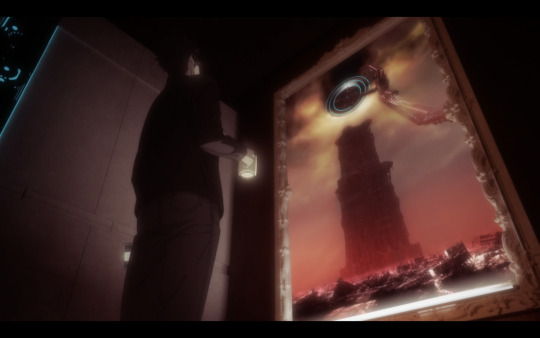
Anyhow, I'm on my fourth rewatch (first time with subs so thank god I can follow the dialogues), and Sibyl has a knack of grinding my gears (pun intended), I've come to despise the System as much as Kogami.
I'll delve into a proper review later, for now just accept my ramblings. I have 10,000 thoughts on Akane too, who in this movie punched me right in the heart, honestly I don't know how Akane-chan is so strong. I admire her grit.
51 notes
·
View notes
Text
Russian forces appear to have increased the number and size of mechanized ground assaults on select sectors of the frontline within the past two weeks, marking a notable overall increase in Russian mechanized assaults across the theater. Ukrainian officials stated on March 20 that Ukrainian forces repelled a large Russian assault in the Lyman direction and published geolocated footage showing Ukrainian forces damaging or destroying several Russian armored vehicles east of Terny (west of Kreminna). Ukrainian forces later defeated a battalion-sized Russian mechanized assault near Tonenke (west of Avdiivka) on March 30 to which Russian forces reportedly committed at least 36 tanks and 12 BMP infantry fighting vehicles (IFVs). A Ukrainian serviceman stated that Ukrainian forces destroyed 12 Russian tanks and eight IFVs during the assault near Tonenke, and Russian forces have likely only conducted one other mechanized assault of that scale along the entire frontline since the beginning of the Russian campaign to seize Avdiivka in October 2023, which was also near Terny on January 20. Geolocated footage published on April 3 shows Ukrainian forces repelling a roughly reinforced platoon-sized mechanized Russian assault near Terny. The April 3 footage is likely recent and is distinct from the March 20 footage of Russian assaults near Terny. Russian forces may be intensifying mechanized assaults before muddy terrain becomes more pronounced in the spring and makes mechanized maneuver warfare more difficult. Russian forces may also be intensifying mechanized assaults to take advantage of Ukrainian materiel shortages before the arrival of expected Western security assistance.
the war, as insane as it may be, continues
21 notes
·
View notes
Text
Two grim milestones just passed for Ukraine: the two-year anniversary of Russia’s full-scale invasion and a decade since the seizure of Crimea. Ukrainians commemorated and grieved. They did so in the midst of mounting uncertainty over the trajectory of the war, the solidarity of their leadership, and the continuance of international support.
Beneath the headlines, however, Ukrainian resistance adapts and evolves. Among Ukrainians, cease-fires and territorial concessions remain broadly anathema. The question is not if resistance should continue, but how.
From the very beginning of Russia’s war, the Ukrainian people self-mobilized en masse. Their proactive agency has been fundamental to Ukraine’s ability to stave off Russian aggression, and it has been lauded as the gold standard in whole-of-society resistance. Following Russia’s annexation of Crimea in 2014, for example, volunteer organizations and civil society groups leapt into action, buying vital time for the military to regroup. In the years that followed, nongovernmental organizations and private interests were integral to sustaining Ukraine’s position in a so-called frozen conflict.
In 2022, as Russian armor surged across the border, ordinary civilians flooded the ranks of the Territorial Defense Forces. These units waged impromptu and ultimately successful localized campaigns to defend cities such as Sumy and Chernihiv, which were fundamental to the disruption of Russia’s invasion plan.
Ukrainian citizens stepped forward to take nonviolent action as well. At times, this occurred in coordination with government entities. Far more often, it was the result of independent initiative. Actions included large-scale street protests, the blocking of roads, and the protection of critical infrastructure. The broader endeavor was punctuated by exceptionally well-amplified face-to-face confrontations and social media campaigns.
Within government-held areas of Ukraine, civil society remains engaged. Key efforts include adapting of drones and other civilian technologies for military use, providing support for displaced families, and raising funds for veteran care. Behind Russian lines, meanwhile, resistance networks have blossomed as well. Some are engaged in sabotage and other guerrilla warfare tactics.
More prevalent, however, have been those engaged in nonviolent resistance. Independent civilian networks have grown dramatically in size and scope, despite limited media attention from the West and negligible external support.
What is their place in Ukraine’s resistance strategy, and how can their achievements inform broader debates over concepts such as “total defense” and the realities of whole-of-society resistance?
As Russia consolidated its hold over areas of southern and eastern Ukraine in the spring of 2022, Ukrainian resistance endured devastating initial setbacks behind the front lines. Most of the “stay behind” partisan groups established by the Ukrainian government were promptly betrayed by pro-Russian collaborators and annihilated. Surviving networks were thereafter culled by Russian intelligence agencies, using surveillance, torture, and collective punishment.
Russia’s occupying administration also enforced a brutal crackdown on civil disobedience and open protest. The result was an utter stifling of overt action. This, combined with Russia’s success in unraveling and destroying clandestine guerrilla networks, created profound unease within the Ukrainian government at the prospect of orchestrating resistance actions (particularly by civilians) behind enemy lines.
Instead, the preference shifted toward hit-and-run raids by Ukrainian special operations forces, launched from government-held terrain.
Despite the Ukrainian government’s uncertain, hands-off approach to civil resistance and the dangers posed under Russian occupation, nonviolent resistance has flourished. Critically, it has done so without the sort of government direction and support envisaged within the total defense paradigm that is increasingly popular within the NATO alliance, and without reliance upon “pre-existing ties and networks” similar to those that have been fundamental to classic resistance movements around the world.
Over the past two years, tens of thousands of Ukrainians have participated in nonviolent resistance activities. Women have been front and center, and new technologies have been pivotal to the scaling, de-risking, and amplification of the enterprise. The actions and outcomes of nonviolent civil resistance have focused overwhelmingly on target audiences within occupied Ukraine, however, and so they remain inadequately understood and appreciated.
Nonviolent resistance has been orchestrated by a decentralized amalgamation of independent groups that reach deep behind the front lines. Rather than building on existing social connections, they have coalesced digitally and anonymously in response to Russian aggression. Maintaining only occasional and informal communication with the Ukrainian government, they have pursued independently conceived courses of action in the furtherance of Ukraine’s national interests.
One of the best-known groups, the Yellow Ribbon Group (YRG), provides an example of this paradigm in practice. The YRG, one of the only resistance groups to garner attention from Western media, originated in Kherson Oblast after the area’s conquest by Russia in the first days of the war. Cut off from Ukraine and unable to take up arms, young people came together to find ways to resist.
“We wanted to be a part of something,” recalls the YRG’s founder, who is not named here to protect their safety. The founder went on to say that they also wished to exert agency in the face of oppression.
Initial resistance activities were predominantly one-off actions by lone individuals. They ranged from tagging pro-Ukrainian graffiti to attaching Ukrainian flags to balloons in order to raise them into the sky. Photos of these actions circulated widely via Telegram channels and on social media, prompting a surge of interest from Luhansk to Crimea.
After Russia’s withdrawal from the right bank of Kherson in November 2022, the YRG expanded its work. Operating from the relative safety of government-held areas, members reached digitally across the front lines to support their fellow Ukrainians enduring occupation. The continued growth and security of practitioners were enabled thereafter by high-tech innovation.
This came in the form of a custom-developed secure messaging platform that allows the practitioners of nonviolent resistance in occupied areas to access an artificial intelligence-enabled chatbot, which provides access to a breadth of information and resources that are automatically customized in response to a user’s prompts.
Examples include instructions on how to print fliers, best practice recommendations for the conduct of certain actions, inspiration for messages and themes. (The latter are often related to current events, such as Elon Musk’s October 2023 assertion that there is no “significant insurgency” in occupied Ukraine, and that Ukraine should cede land for peace.)
Within this system, the YRG has established the digital backbone of a resistance network unlike any other in history: one with a single hub run via artificial intelligence (as opposed to an identifiable leadership team) and an unlimited series of anonymous, untraceable, individual spokes. The entire application can be deleted from the user’s phone at the push of a button, and full anonymity means that members of the network cannot be compromised by Russia.
YRG practitioners have also produced posters exposing the identities and activities of administrators within the occupation bureaucracy. At times, these efforts target high-profile public figures—such as the infamous pro-Russian politician and former Kherson Mayor Vladimir Saldo—but primary focus goes toward midlevel officials imported from Russia to prove that the resistance knows who they are. In a number of instances, these exposés have compelled the individuals in question to relocate, which in turn adds an additional burden on the occupation and heightens the sense of insecurity.
In a pattern evident throughout the nonviolent resistance movement in occupied Ukraine, the more active that YRG becomes, the more that it grows in numbers. The structure of its digital platform is such that it can accommodate any and all new entrants, while its architecture mitigates any damage that might accrue through Russian penetration.
According to internal system metrics, the YRG’s platform has approximately 10,000 registered users, with an average of 3,000 active users within a given week. Sources within the YRG note that numbers fluctuate dramatically at any given moment, since users will delete the application on a regular basis when approaching checkpoints and other high-risk areas.
Another prominent nonviolent resistance network leveraging technology, anonymity, and female agency is the Angry Mavkas. The group is comprised exclusively of Ukrainian women, and it draws its name from a siren-like creature in Ukrainian folklore that lures men to their deaths.
The Mavkas began in Melitopol among a small group of women who wanted to push back against Russian aggression and sexual assault, which has been systemic under occupation. The Mavkas’ reputation spread quickly, and the group’s founders were inundated with requests from women and girls across the occupied territories to contribute to their cause.
As with the YRG, the Mavkas utilize their own anonymous communication platform to share resources and stories, coordinate activities, and present digital evidence of their actions. The result creates an interesting duality: It is a forum that provides Ukrainian women the opportunity to connect with one another and vent their fears and frustrations under occupation, but it is also a space of anonymous, digital strangers.
Discussions with participants in Ukraine’s nonviolent resistance movement emphasize the value of both the act of practicing resistance as well as the outcomes that it generates. Taking action has been a powerful means of asserting agency and “speaking freely” under occupation. Practitioners noted what they called the “self-imposed schizophrenia” that is required of Ukrainian patriots, wherein one must publicly acquiesce to Russian rule in order to survive. For example, accepting a Russian passport is now a precondition for access to basic medical care, pensions, and permission to leave one’s city in the occupied territories.
As Russian surveillance and counterintelligence capabilities grow increasingly robust, there is little opportunity for respite or self-expression. As such, public trust has been badly degraded in occupied territories—a further constraint to the practice of resistance via traditional social groups. In the view of a senior figure within the Mavkas, the ensuing “social atomization” evokes the communist era. In the words of another practitioner, “our lives have become compartmentalized.”
Trapped in a world where one must say and do things that run counter to one’s core beliefs, and where one cannot express true feelings outside of extremely narrow circles of trust, even the smallest acts of resistance imbue powerful psychological impacts for the practitioner—and also for their fellow Ukrainians enduring occupation, who witness the results.
The successes of the nonviolent resistance movement have catalyzed shifts in Russian messaging as well. Initially, Russian officials ignored such acts of resistance. As activity grew to the point that it could not be ignored, the Russians sought to dismiss and discredit the endeavor. According to sources in the YRG, nonviolent resistance is said by the Russians to be the work of “a duped, intellectually deficient few.” They say that the YRG has been cast as “a band of degenerates” and “while the Mavkas are alleged to be “a psyop [psychological operations] run from Kyiv” as well as tools of the U.S.
In contrast to the devastating early losses suffered within traditional partisan networks established and run by the Ukrainian government, the decentralized and anonymous digital networks established by civil society are thriving. The YRG and the Mavkas continue to expand while other groups are still emerging. The Combat Seagulls blend violent and nonviolent practices in Crimea, while Atesh (meaning “fire” in Crimean Tartar) is a network of saboteurs and informants drawn primarily from Tartars forcibly conscripted by Russia.
Resistance is growing in occupied Ukraine, both in scale and sophistication. Armed partisan networks are making their presence felt behind the front lines while nonviolent resistance groups continue to expand. Critically, the Ukrainian government is recognizing integrated resistance as a strategic lever.
This two-pronged approach to resistance—violent and nonviolent actions synchronized in support of a shared objective—offers a compelling paradigm. This is particularly true as nonviolent civil networks have shown the ability to move beyond small-scale symbolic actions and toward more ambitious campaigns.
In early 2023, for example, the Mavkas orchestrated the large-scale production of counterfeit 50-ruble notes, with a twist. With several details changed—only noticeable after close inspection—the notes were designed to grab the attention of Russians and others when left in public places, for example, at ATMs.
Activists were able to print and disseminate bills in Crimea, Melitopol, and parts of Kherson. Entering broadly into circulation, the notes initiated a flurry of official condemnation from Russian authorities.
The second campaign, conducted by a partisan network that has not yet taken public credit, was launched during the elections conducted by Russian authorities across occupied Ukraine in September 2023. In the run-up to the vote, aspiring local politicians put up posters to advertise their candidacy.
In the midst of this activity, a partisan network produced realistic posters of its own for fictitious candidates in the occupied territories, complete with scannable QR codes similar to those used by the official politicians These QR codes led in different directions: Some links went to videos of Russian opposition figure Alexei Navalny, others to resources describing human rights violations within Russia, and others to spoof voter registration websites. These resources were hosted on secure platforms that had been paid for with cryptocurrency, which the Russian government could neither hack nor trace.
On the contrary, this subtle but effective campaign not only disrupted the so-called elections in occupied Ukraine, but also exposed the futility of Russia’s attempt to use democracy as a weapon.
Russia reacted sharply, and in ways that subverted narratives with which they have sought to legitimize conquest and occupation. First, high-level figures from Russia’s Central Election Commission publicly and aggressively condemned the effort and Rostelcom, the Russian state-owned digital services provider, pressed the relevant hosting services to take the websites down. Second, Russian media entities such as the news agency TASS, the website “War on Fakes” (widely understood to be linked to the Russian Ministry of Defense), and the popular show Solovyov Live alleged that the campaign was the work of scammers or Ukrainian psyops units. The net effect was official acknowledgement of substantive local opposition within the occupied territories, and the amplification of Ukrainian resistance to audiences across Russia.
As Ukraine explores the potential of nonviolent resistance—potentially aligned with a wider campaign of guerrilla activity in the occupied territories—the government must find a way to harness civilian networks without subsuming them. Civil society under government control is no longer civil society, irrespective of the statist assumptions baked into total defense and resistance paradigms proffered within NATO. Leaders in Kyiv need only to look across their northern and eastern borders to witness the toxic fallout of an instrumentalized populace.
There is ample room to coordinate and support the work of civilian resistance networks. Critically, that effort relies on mutual trust: for practitioners to be supported and empowered, and for the government to establish constructive strategic dialogue with the networks in question.
Nonviolent resistance has been a spontaneous expression of national will. It has been the civilian counterpart to the formidable Ukrainian “will to fight” evident on the battlefield, and its potency comes from the legacy of a decadeslong progress through which civil society has stepped forward, time and again, to shape Ukraine’s political future.
In the wake of two somber anniversaries, facing an interminable war of national survival with uncertain support from abroad, the Ukrainian people remain Ukraine’s most potent strategic asset. Within the occupied territories, civil resistance is vital to subverting Russian propaganda and framing the terms of any future negotiations. On the global stage, the sustained commitment and sacrifice of the Ukrainian people remains the most potent argument for continued international support. Re-establishing their place as the face and voice of resistance—a status that they achieved to extraordinary effect during the initial moments of the full-scale invasion—offers Ukraine its best opportunity to endure the challenges to come.
36 notes
·
View notes
Note
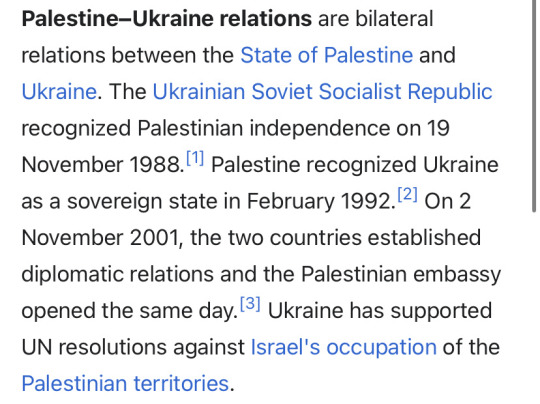
I’m not trying to start a fight/argue, but Ukraine has always supported Palestine. I think it’s important to know that since they themselves are getting invaded, Ukraine isn’t really in a position to put too much involvement in other countries affairs at the moment. But historically, the two have always had good relations
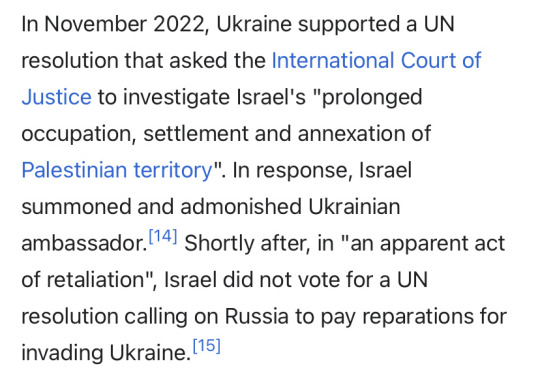
Ukraine doesn’t like Israel, if that’s not obvious.
But Ukraine and Palestine have long recognized each other’s independence. The two are more similar than people realize.
(Again, I’m not trying to be disrespectful, I just want to clarify some Information.)
I promise I won't fight or argue 😉 I'm only occasionally a horrid asshole when people attack me personally, but I love talking kindly with people I disagree with <3
I definitely think things are a little more complicated between Ukraine's support of Israel than, say, the United State's support of Israel, but there is still support-- allow me to state my case why. Bear with me, it requires some context.
I think the most important thing to point out first is that that this support was historic. The state of Ukraine supported Palestine as a Soviet Republic, just as all communists support liberation and oppose apartheid and genocide everywhere. I'm not sure what would have happened after 1991 following the dissolution of the socialist project, but even after the capitalist coup of the Union, these post-socialist societies retained much of their Soviet values ideologically and morally, as well as their international relationships; it would not have surprised me if Ukraine from 1991 to 2014 maintained support of Palestine.
However, the neutral Ukrainian government in 2014, which had good relations with both Westerners in Europe as well as their sibling nation Russia, was couped by the Westerners. What then began was a process of liberalization, militarization, and Nazification of the political and military body.
The Banderites are a group of Ukranian Neo Nazis who are directly and descended without interruption from the original Ukranian Nazi collaborators--as the Nazis raped and pillaged and slaughtered their way eastward in the opening days of WW2, many Eastern Europeans joined their ranks, both fascist individuals happily joining in the destruction of their Jewish, Slavic, etc. neighbors, and also those who were fearful, or just opportunists. Banderites remained a fringe political movement in the underground of Ukrainian politics for a century--while the fall of the Soviet Union in 1991 made their anticommunist, fascist, white supremacist ideology a little freer to stretch its legs, it wasn't until the 2014 coup and its aftermath that they were truly enabled. And enabled they were: Western weapons, ammo, armor, vehicles, intel, military trainers, mercenaries, political favors, and vast sums of money helped the Banderite movement take power in Ukraine. For 8 years, children began being taught Nazi ideology in public schools, groups that were previously underground Neo Nazi paramilitary groups were integrated formally into the military and political body, and those deemed ethnically inferior such as African or Arab immigrants and their more Slavic Russian-speaking neighbors at the east end of Ukraine were harassed, assaulted, killed--bombed, sniped, burned alive.
America and NATO purposefully provoked Russia to invade Ukraine in 2022 as part of their geopolitical strategy since the end of WW2 to contain, weaken, and, eventually, balkanize and colonize Russia.
I won't dig into the details of this conflict, but, suffice to say, it is only through the billions and billions of American dollars that this war didn't end in a few short months.
Likewise, if it wasn't for the billions and billions of American dollars that Israel receives, Israel would have been destroyed by its Arab neighbors generations ago.
Here arises a conflict that the Ukrainian government shares with the Israelis: they both compete to be USA's #1 vassal and to be granted massive subsidies to continue their fascist projects. A dollar sent to Ukraine is a dollar that could have been sent to the IDF, and vice versa.
There is other small geopolitical kinks: Israel and Russia occasionally collaborate in Syria to fight ISIS. Many of the Jews that immigrated to the newly formed Israel came from both Ukraine and Russia.
Now, besides these kinks, including the two UN resolutions you cited, there is no indication that post-2014 Ukraine and Israel are anything but amicable, and support each others respective fascist ideologies, even with the seeming paradox that one is explicitly antisemitic and the other proclaims itself to be the sole voice of Judaism.
Zelensky and Netanyahu have amicable diplomatic relations. They have visited each other's countries many times, and taken turns denouncing Hamas and Russia, respectively. They each publicly support each others sovereignty, urge continued cooperation, and have taken small steps to strengthening political, economic, and militaristic ties, including the exchange of intel, weapons, and training.
The situation is complicated, but the final tally is clear: they are both vassals of the United States, they are both embroiled in hot wars that rely heavily on the approval and charity of American and European citizens and institutions, and whatever feelings they may share privately are secondary to that fact. Perhaps they secretly don't like each other, and see each other as competitors, and only work together under the duress of the United States. Perhaps they love each other, greatly admire each other, and things like the UN resolution are a lover's spat, and reluctance to fully cosign each other is the result of the petty game of necessary geopolitical posturing for their ultimate goals. Perhaps it is a bit of both. But, the end result is the same: they are both minions subordinate to the United States, and thus in this 3rd World War, they are allies, however strange bedfellows they may appear.
#russia#ukraine#israel#palestine#hamas#free gaza#ukranian#russian invasion#oct 7#from the river to the sea palestine will be free#gaza aid#gaza strip#geopolitics#marxism leninism#political analysis#ww3#history#socialism#fascism#antisemitism
18 notes
·
View notes
Photo
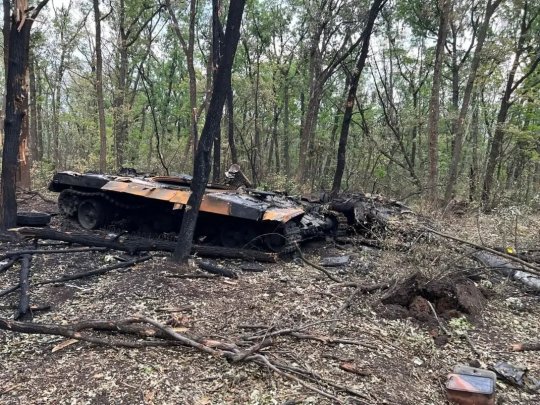

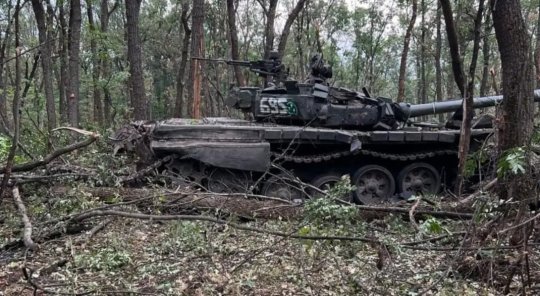
Two more Russian T-72 main battle tank successfully demilitarized by Ukrainian airborne forces, Ukraine, 2022. Photo by 25th Paratrooper Brigade of the Ukrainian Army. Source: Defence of Ukraine
#Ukraine#russian invasion#forest#T-72#main battle tank#russian armor#russian defeat#russian losses#tank#destroyed russian tank#ukrainian independence war#defense of europe#war#military history#airborne troops
15 notes
·
View notes
Text

Putin Says Western Bases Hosting Ukraine’s F-16s Would Be Legitimate Targets
March 28, 2024 Russia, War in Ukraine
Putin F-16
F-16 firing an AGM-88 HARM. In the box, Vladimir Putin. (Image credit: The Aviationist, using images in the Public Domain)
Russia warns it may attack NATO bases possibly used to launch Ukraine’s F-16s.
If the F-16s are delivered to Ukraine, Russia could also strike NATO bases from which the jets would launch. The threat was issued by Vladimir Putin during a meeting with a group of pilots at Tver, northwest of Moscow. The Russian President said an escalation could be provoked by the delivery of the promised Fighting Falcon jets, for which training of Ukrainian pilots is underway.
“F-16s are capable of carrying nuclear weapons, and we will also need to take that into account while organizing our combat operations,” Putin said.
“Of course, if they are used from bases in third countries, they would be a legitimate target for us, no matter where they are,” he added.
However, the Kremlin believes not even the supply of these fighters will be able to change the course of the conflict, “We will destroy their warplanes just as we destroy their tanks, armored vehicles and other equipment, including multiple rocket launchers”.
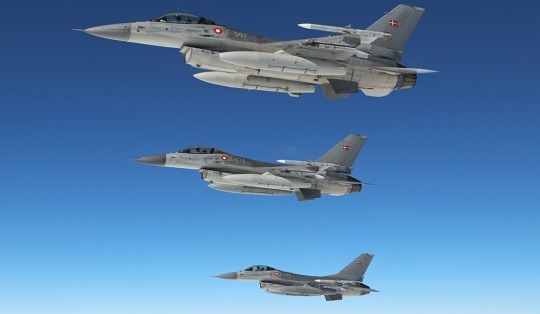
File photo of Danish F-16s. (Photo: Danish MoD)
Ukraine has long been asking its Western partners for the delivery of F-16s. Ukrainian President Zelenskyy said last year that at least 42 F-16s had been promised (the number is not known, but according to the most reliable sources, they should be 60), with the first deliveries expected by the Summer of 2024. Meanwhile, Ukrainian pilots, with different degree of flying experience, are at various stages of training, both in the U.S. and in Europe.
The delivery of the F-16s won’t be a game-changer, considering the need to integrate them in the Ukrainian Air Force, the lack of specific experience of Ukrainian pilots on the type and in view of Russia’s massive air force and sophisticated air defense systems. The weapon system requires logistic support, infrastructure and weapons: it will take years before the whole “ecosystem” that is required to sustain effective combat operations with the Fighting Falcon can be exploited at its best.
F-16 Ukraine
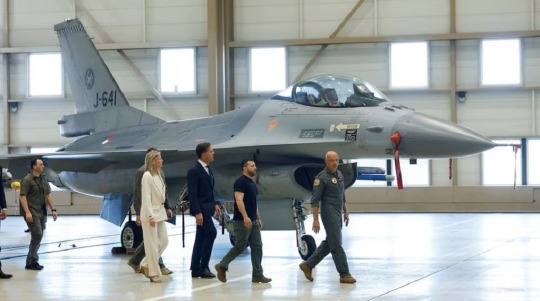
Ukrainian President Volodymyr Zelenskiy and Dutch Prime Minister Mark Rutte walk near an F-16, in Eindhoven, Netherlands, August 20, 2023. (Photo credits: REUTERS/Piroschka van de Wouw)
However, in the short and mid term, the “Viper” (as the F-16 is nicknamed in the pilot community) will be a quick upgrade from the current MiG-29s: the “new” jets will be used to detect, hunt and engage cruise missiles, helicopters, UAVs and Russian fighters, and to conducting air strikes on Russian targets with stand-off missiles. The F-16s can also be used to fire the AGM-88 HARM missiles (a type that was not “natively” compatible with the Ukrainian combat aircraft but was integrated with the MiG-29 and Su-27) and JDAMs bombs in SEAD/DEAD (Suppression/Destruction of Enemy Air Defenses) missions that are particularly important on the Ukrainian battlefield.
We will see.
MiG-29 AGM-88
A screenshot of the video shared by the Ukrainian Air Force showing the moment an AGM-88 HARM is fired by a MiG-29.
About David Cenciotti
@theAviationist via X
David Cenciotti is a journalist based in Rome, Italy. He is the Founder and Editor of “The Aviationist”, one of the world’s most famous and read military aviation blogs. Since 1996, he has written for major worldwide magazines, including Air Forces Monthly, Combat Aircraft, and many others, covering aviation, defense, war, industry, intelligence, crime and cyberwar. He has reported from the U.S., Europe, Australia and Syria, and flown several combat planes with different air forces. He is a former 2nd Lt. of the Italian Air Force, a private pilot and a graduate in Computer Engineering. He has written five books and contributed to many more ones.
9 notes
·
View notes
Text
Man, I know we're not supposed to talk about problems of Russians during this war, but like...
I'm Russian, so I'm gonna talk about the problems of Russians.
This mobilization effort is fucking mental.
They're literally sending untrained IT guys and lawyers who never held a rifle in their life with 10 (TEN!) days of training during which they don't even shoot to the front lines. Where they die without doing anything to the professional and well-equipped Ukrainian soldiers.
People are reading up instructions on how to use grenade launchers while they're riding to the combat zone.
Men, young and old, who never had proper combat training, let alone the taste of real combat are sent within range of artillery with no proper fucking support, their APCs and tanks are low in numbers and get destroyed on the way there and they're left to fight with no equipment, no support, no proper medical equipment NOTHING.
People are told to buy their own underwear, helmets, armored vests and fucking tampons to plug the bullet holes.
All of that while Ukrainians are suffering minimal casualties.
This is not a smart military move by any metric. Putin is literally attempting to drown Ukrainians in meat and blood of his own people, MY people.
And all for what?
To stop gender ideology and "the satanic West". Over some land that never belonged to him.
Do you fucking understand what's wrong with this regime yet?
Do you truly think this man cares about the people of Russia or anything but staying in power?
206 notes
·
View notes
Text
Rare POV footage of a Ukrainian FGM-148 Javelin team from the 79th Air Assault Brigade attacking a Russian column outside of Marinka, destroying multiple armored vehicles.
20 notes
·
View notes
Text
🇷🇺⚔️🇺🇦 🚨
INTENSE BATTLES AS RUSSIAN FORCES BREAK THROUGH UKRAINIAN DEFENSES NEAR ROBOTINO IN ZAPOROZHYE
📹 Ukrainian footage showing the breakthrough of Russian Forces of Ukraine's defensive belt near the village of Robotino in the Zaporozhye sector.
Russian Forces from the Southern Military District and Airborne Forces launch a powerful attack on the Ukrainian defensive belt, pushing more than 2km into Ukrainian-held territory, won through great sacrifice during last year's Ukrainian offensive in the Zaporozhye direction.
In the footage, Ukrainian forces destroy several pieces of Russian equipment and systems, though it does little to slow the Russian advance, with one tank being hit directly, only to storm forward mostly undamaged.
Russian landing forces then disembark from armored vehicles under BMP suppressive fire and secure several enemy positions.
Russian Forces manage to breakthrough into the village of Robotino, capturing positions of the Armed Forces of Ukraine and capturing or killing many Ukrainian militants.
In another operation, Russian Forces also announced the capture of the village of Pobeda, south of the recently captured city of Marinka in the South Donetsk direction.
“In the Donetsk direction, units of the Southern Group of Forces liberated the village of Pobeda,” the Russian Ministry of Defense said.
According to the Ministry of Defense, Ukrainian forces in the South Donetsk direction lost over 410 servicemembers, one tank, three armored vehicles, five military vehicles, one Polish-made Krab and one Bogdan self-propelled artillery systems, one D-20 howitzer, and a self-propelled Gvozdika artillery system.
#source
#videosource
@WorkerSolidarityNews
#ukraine#ukraine news#ukraine war#russia#russian federation#russia news#russian news#russo ukrainian war#russia ukraine war#russia ukraine conflict#russia ukraine crisis#war in ukraine#special military operation#russian military#russian armed forces#armed forces of ukraine#ukrainian military#military news#war#eastern europe#europe#europe news#politics#news#geopolitics#world news#global news#international news#breaking news#current events
10 notes
·
View notes
Text

Honour guard soldiers prepare to rise the Ukrainian national flag during State Flag Day celebrations in Kyiv, Ukraine, Tuesday, August 23, 2022. (Ukrainian Presidential Press Office via AP)
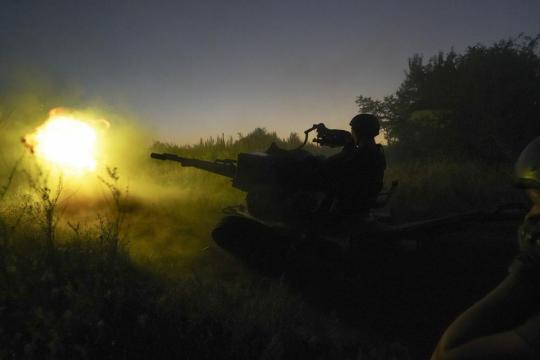
Ukrainian servicemen fire to Russian positions from anti-aircraft gun in Kharkiv region, Ukraine, early Wednesday, August 24, 2022. (AP Photo/Andrii Marienko)

Dmytro Shengur cleans rubble in front of the house which was damaged after Russian bombardment of residential area in Nikopol, Ukraine, on Monday, August 22, 2022. In Nikopol, across the river from Ukraine's main nuclear power plant, Russian shelling wounded four people Monday, an official said. The city on the Dnipro River has faced relentless pounding since July 12 that has damaged some 850 buildings and sent about half its population of 100,000 fleeing. (AP Photo/Evgeniy Maloletka)

Russian rockets launch against Ukraine from Russia's Belgorod region are seen at dawn in Kharkiv, Ukraine, early Saturday, August 20, 2022. (AP Photo/Vadim Belikov)

People walk around destroyed Russian military vehicles installed in downtown Kyiv, Ukraine, Wednesday, August 24, 2022. Kyiv authorities have banned mass gatherings in the capital through Thursday for fear of Russian missile attacks. Independence Day, like the six-month mark in the war, falls on Wednesday. (AP Photo/Evgeniy Maloletka)
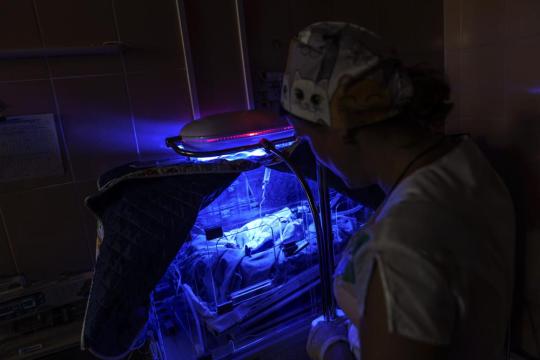
Dr. Tetiana Myroshnychenko, a neonatologist at Pokrovsk Perinatal Hospital, checks on Veronika, a baby born nearly two months prematurely, in Pokrovsk, Donetsk region, eastern Ukraine, Monday, August 15, 2022. In Ukraine’s war-torn eastern Donetsk region, only one hospital under government control remains equipped to care for babies born prematurely in government-held areas. Doctors say the stress caused by the war and rapidly worsening living conditions are leading to more frequent birth complications for the area's pregnant women. (AP Photo/David Goldman)

A blanket covers the incubator where Veronika, a baby born nearly two months prematurely, is cared for at the Pokrovsk Perinatal Hospital, in Pokrovsk, eastern Ukraine, Monday, August 15, 2022. When the air-raid sirens sound, the babies in the over-ground incubation ward cannot be disconnected from life-saving machines, explains Dr. Tetiana Myroshnychenko. "If I carry Veronika to the shelter, that would take five minutes. But for her, those five minutes could be critical," Myroshnychenko says. (AP Photo/David Goldman)

A dog sits inside a destroyed shopping center, as Russia's attack in Ukraine continues, in Bakhmut, Donetsk region, Ukraine, Sunday, August 21, 2022. (REUTERS/Ammar Awad)

Tatiana Marinchenko touching her husband, Oleg Marinchenko, a Ukrainian soldier, while joined by her father-in-law, Ivan Marinchenko, and her daughter, Ira Kalinichenko, at a funeral for Oleg in Kyiv on Tuesday, August 23, 2022. Mr. Marinchenko was killed on August 19 in a mortar attack in the Kherson region while working as a medic and chaplain with the Ukrainian military. (Lynsey Addario/The New York Times)
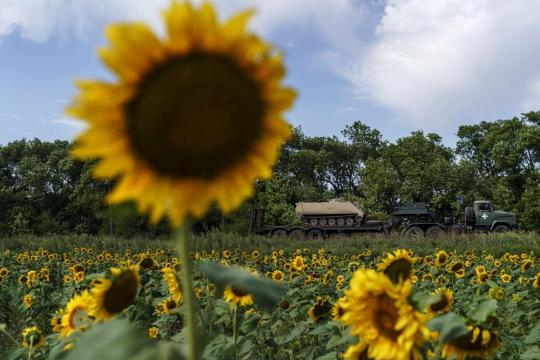
An armored personnel carrier is transported past a sunflower field toward the frontline in the Donetsk region, eastern Ukraine, Monday, August 22, 2022. (AP Photo/David Goldman)
163 notes
·
View notes